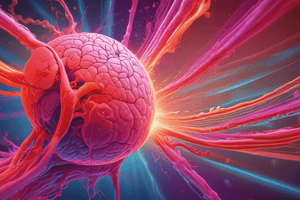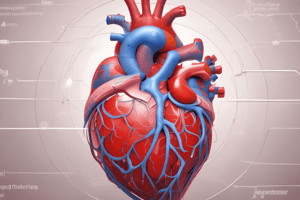Podcast
Questions and Answers
_____________________________ can be defined as the study of abnormalities in physiologic functioning of living beings.
_____________________________ can be defined as the study of abnormalities in physiologic functioning of living beings.
Pathophysiology
Which of the following is an example of a symptom?
Which of the following is an example of a symptom?
- Headache (correct)
- Vomiting
- Bruise
- Observing enlarged lymph nodes
Most diseases are multifactorial.
Most diseases are multifactorial.
True (A)
What is the definition of etiology?
What is the definition of etiology?
Signs can be defined as a subjective clinical manifestation.
Signs can be defined as a subjective clinical manifestation.
Match the following terms with their definitions:
Match the following terms with their definitions:
Every individual exposed in a population will contract the disease.
Every individual exposed in a population will contract the disease.
What defines the prodromal period of an illness?
What defines the prodromal period of an illness?
Which tumor markers are associated with prostate cancer and ovarian cancer?
Which tumor markers are associated with prostate cancer and ovarian cancer?
Grading refers to the histologic characterization of tumor cells, while staging is concerned with the location and spread patterns within the host.
Grading refers to the histologic characterization of tumor cells, while staging is concerned with the location and spread patterns within the host.
What role do B cells play in the immune response?
What role do B cells play in the immune response?
Monocytes mature into ______.
Monocytes mature into ______.
Match the immune cells with their primary functions:
Match the immune cells with their primary functions:
Inflammatory cytokines do not lead to the release of immature neutrophils from the bone marrow during bacterial infections.
Inflammatory cytokines do not lead to the release of immature neutrophils from the bone marrow during bacterial infections.
What are the five cardinal signs of inflammation?
What are the five cardinal signs of inflammation?
Chronic inflammation may promote healing and reduce fibrosis.
Chronic inflammation may promote healing and reduce fibrosis.
Which of the following is an example of autosomal aneuploidy?
Which of the following is an example of autosomal aneuploidy?
Males always express the disease for a sex-linked (X-linked) disorder.
Males always express the disease for a sex-linked (X-linked) disorder.
What are two examples of a sex chromosome aneuploidy?
What are two examples of a sex chromosome aneuploidy?
Cancer is the __________ leading cause of death in the U.S.
Cancer is the __________ leading cause of death in the U.S.
Match the syndrome with its corresponding description:
Match the syndrome with its corresponding description:
Which immunoglobulin is the first to be produced on exposure to antigens?
Which immunoglobulin is the first to be produced on exposure to antigens?
Type II hypersensitivity is known as tissue-specific.
Type II hypersensitivity is known as tissue-specific.
What is the pathophysiology of malignant tumors?
What is the pathophysiology of malignant tumors?
What are the five classes of immunoglobulins?
What are the five classes of immunoglobulins?
The suffix 'oma' typically indicates malignant tumors.
The suffix 'oma' typically indicates malignant tumors.
Name the two groups that cancer-critical genes are classified into.
Name the two groups that cancer-critical genes are classified into.
Hypersensitivity is divided into ________ types.
Hypersensitivity is divided into ________ types.
Match the immunoglobulins with their functions:
Match the immunoglobulins with their functions:
What is the primary category of immune disorders caused by inappropriate immune responses?
What is the primary category of immune disorders caused by inappropriate immune responses?
Selective IgA deficiency is an example of a T cell disorder.
Selective IgA deficiency is an example of a T cell disorder.
What type of hypersensitivity is persistent asthma an example of?
What type of hypersensitivity is persistent asthma an example of?
Which of the following best describes 'pathogenesis'?
Which of the following best describes 'pathogenesis'?
The latent period is the time when first symptoms of a disease appear.
The latent period is the time when first symptoms of a disease appear.
What does the term 'exacerbation' mean?
What does the term 'exacerbation' mean?
The type of injury that is irreversible is known as __________.
The type of injury that is irreversible is known as __________.
Match the terms with their definitions:
Match the terms with their definitions:
What do positive and negative predictive values indicate in diagnostic testing?
What do positive and negative predictive values indicate in diagnostic testing?
An epidemic refers to a disease that spreads to many at the same time.
An epidemic refers to a disease that spreads to many at the same time.
List two risk factors that can contribute to a multifactorial disease.
List two risk factors that can contribute to a multifactorial disease.
Flashcards are hidden until you start studying
Study Notes
Introduction to Pathophysiology 1
- Pathophysiology studies abnormalities in physiological functions, revealing the body's responses to environmental disruptions.
- Key factors affecting individual disease presentation include health structure and function.
- Four topics in pathophysiology: Etiology, Pathogenesis, Clinical manifestations, Treatment implications.
- Most diseases are multifactorial, influenced by various risk factors.
- Iatrogenic causes result from medical treatment, exemplified by chemotherapy-induced hair loss.
- Not every exposed individual contracts a disease, indicating variable susceptibility.
- The immune system is an intercellular communication network.
- Pathogenesis refers to disease evolution from initial stimulus to manifestation.
- Etiology classifies disease causes as idiopathic (unknown) or iatrogenic (treatment-related).
Clinical Manifestations
- Signs are objective clinical manifestations; symptoms are subjective.
- Example of a symptom: headache; observable signs include enlarged lymph nodes.
- Latent period: time until signs/symptoms appear; prodromal period: onset of first signs/symptoms.
- Acute phase: disease's peak intensity; remission: decrease in severity; exacerbation: sudden increase in severity.
- Sequela: subsequent pathological condition following an illness.
Genetic Disorders
- Four groups of genetic disorders are normal, chromosomal abnormalities, single gene disorders, and multifactorial conditions.
- Chromosomal abnormalities often result from aneuploidy, a deviation from the normal chromosome number.
- Examples of aneuploidy include Trisomy 21 (Down syndrome), Trisomy 18 (Edwards syndrome), and Trisomy 13 (Patau syndrome).
- Sex chromosome aneuploidies: Turner syndrome (XO) and Klinefelter syndrome (XXY).
- Cri du Chat Syndrome results from a deletion in chromosome 5.
- Marfan Syndrome is an autosomal dominant disorder affecting connective tissue.
Neoplasia
- Neoplasia refers to "new growth" of cells, categorized as malignant (cancerous) or benign (non-cancerous).
- Tumor suffix "-oma" usually indicates benign growth, while terms like "carcinoma" indicate malignancy.
- Cancer is the second leading cause of death in the U.S.
- Carcinogenesis involves three steps: initiation, promotion, and progression.
- Tumor markers, like PSA for prostate cancer and CA-125 for ovarian cancer, help identify cancer origin.
Inflammation and Immunity
- The immune system comprises white blood cells and various inhibitors and mediators.
- Monocytes originate from bone marrow and mature into macrophages upon migrating to tissues.
- T cells mature in the thymus; B cells mature in the bone marrow and produce antibodies.
- Adaptive immunity consists of humoral (B cells) and cell-mediated (T cells) responses.
- Major histocompatibility complex (MHC) proteins present antigens to T cells.
Immune Function Alterations
- Inappropriate immune responses can be classified into autoimmune and hypersensitivity disorders.
- Autoimmune diseases are more prevalent in females than males.
- Hypersensitivity is an exaggerated immune response, divided into four types.
- Type I hypersensitivity triggers immediate reactions through IgE antibodies, occurring shortly after exposure.
- Type II hypersensitivity, or tissue-specific reactions, involve IgG or IgM antibodies.
- Persistent asthma is a form of Type IV hypersensitivity, leading to chronic inflammation.
Summary of Immune Responses
- Primary immune deficiencies include genetic disorders like Wiskott-Aldrich Syndrome.
- HIV/AIDS primarily decreases T cell counts, resulting in increased susceptibility to infections.
- The deletion of chromosome 22 is associated with DiGeorge Syndrome.
Studying That Suits You
Use AI to generate personalized quizzes and flashcards to suit your learning preferences.





